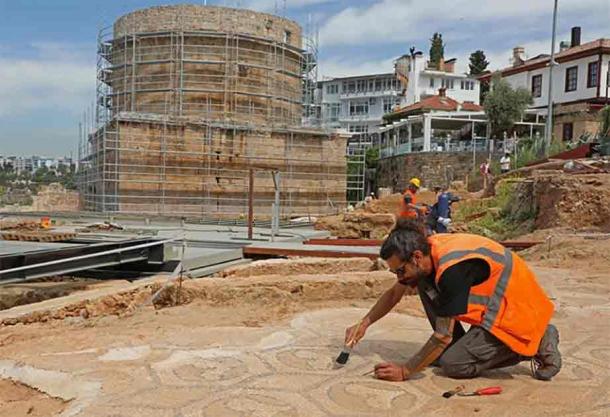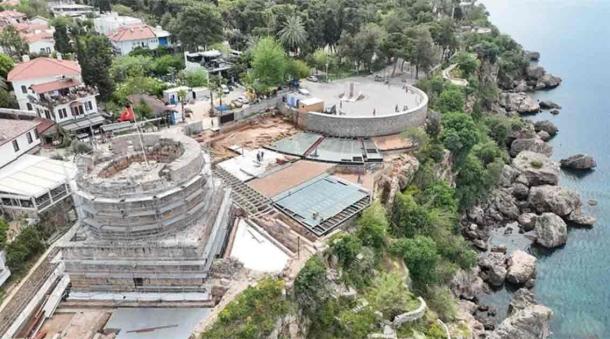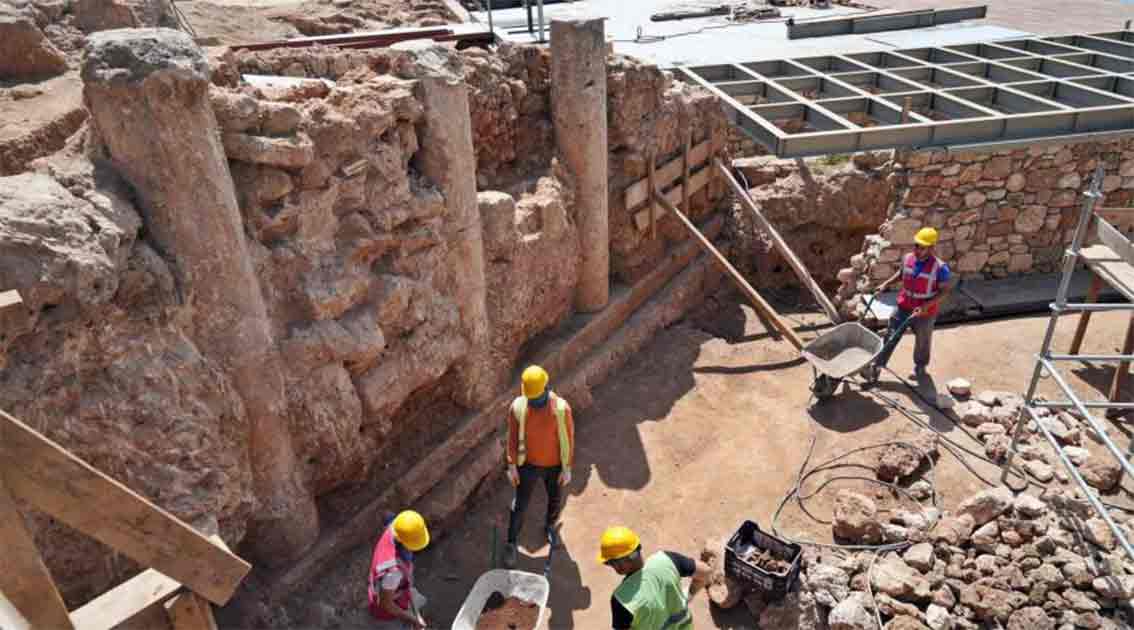2nd Century Colonnaded Roman Road Unearthed in Turkey
During recent excavations along Turkey’s southwestern Mediterranean coastline in the city of Antalya, archaeologists have found something big. A partial section of a colonnaded road has been excavated which dates back to the Roman era, which for this town began in 133 BC.
Originating near the city’s ancient protective walls, the spectacular avenue is estimated to be 2,625 feet (800 meters) long. However the majority remains under the ground, and only 330 feet (100 meters) of it have been dug up so far.
The city of Antalya is already known for its impressive collection of Roman structures and ruins, which have helped make it the fourth-most visited city in the world. The hidden Roman street freshly excavated from the bedrock will be added to the ever-growing list of its wonders, giving tourists yet another Roman creation at which to marvel.
Roman Builders Were Busy in Antalya
The buried remnants of the road and the columns that lined its sides were unearthed during excavations being carried out in conjunction with the restoration of Hıdırlık Tower and its surrounding area, sponsored by the Metropolitan Municipality of Antalya and the Antalya Museum Directorate. This striking Roman-era monument is a major tourist attraction in a popular resort city that attracts over 16 million visitors annually.
- Built to Last: The Secret that Enabled Roman Roads to Withstand the Passage of Time
- First Roman Temples from 2,000 Years Ago Found in the Netherlands

A mosaic floor is uncovered near to Hıdırlık Tower (Antalya Metropolitan Municipality / Anatolian Archaeology)
“It is one of the important findings of Kaleiçi [Antalya’s central district],” stated Antalya Metropolitan Municipality Survey Project Branch Manager Ezgi Öz said in a statement about the Roman road issued to the media. “It extends to Üçkapılar [Hadrian’s Gate] and we found its connection to the sea.”
Hadrian’s Gate is another Roman period structure, which was named in honor of the Roman emperor Hadrian, who visited the city in 130 AD. This colonnaded gate functioned as an entrance point through the city walls, which were built in ancient times to surround and protect the city of Antalya and its harbor.
Given that Hadrian’s Gate and Hıdırlık Tower are the two most famous Roman landmarks in Antalya, uncovering a road connecting them represents a significant find. Excavations have also uncovered several mosaics, believed to come from a Roman bathhouse, a villa and a Cretan ice factory.
Based on its incredible antiquity, Hıdırlık Tower has become the centerpiece of the municipality of Antalya’s efforts to make their city even more attractive to visitors with an intense interest in ancient history.
- Study Reveals Lasting Prosperity Along the Roman Road Network
- Roman Seals Showing Hundreds of Gods Unearthed in Turkey

The site of the excavation where the colonnaded Roman road has been found (Antalya Metropolitan Municipality / Anatolian Archaeology)
Initially, the lower section of what became Hıdırlık Tower was intended to be used as a mausoleum by an influential Roman senator and his family. But later in the second century the state took possession of it and remodeled it for use as a defensive fortification and lighthouse, its proximity to the coastline and local harbor making it ideal for such purposes.
At this time a circular surveillance tower was added to its rectangular base. It is in this form that the tower has been preserved by residents of Antalya for the past 1,800-plus years.
As part of the current efforts to keep the tower in good shape, preservation experts are cleaning and restoring its damaged or worn areas inside and out. It is hoped that this will ensure that the two-story, stone-block structure will remain in excellent condition for decades to come.
But the scope of the ambitious restoration project extends far beyond this. Ongoing excavations have produced many fascinating finds, which in addition to the newly discovered roads include Roman villa mosaics and baths in and around the tower’s ground floor. Other finds at the site include structures and ruins dating to later Byzantine and Seljuk eras, showing that the tower and its adjacent infrastructure remained in use for many centuries beyond Roman times.
Everything is being cleaned and restored, and the final piece of the puzzle will be the creation of a multilevel and easily accessible archaeological plaza where tourists can see everything that has been found during the various excavations connected to Hıdırlık Tower.
“When the works are completed, important structures will be exhibited through glass coverings, and there will be wooden walking areas in other areas,” Öz explained. “An important work was done in the public sense … it is planned to be completed by mid-summer. Conservation works are progressing rapidly, after which the works on the terrace will be realized.”
Archaeological teams are excavating the remaining parts of the colonnaded Roman road as fast as they can. Once this work is complete the road will be put on prominent display in the archaeological showcase that is being constructed, highlighting the fact that it served as a vital link connecting the interior of the ancient city with the entrance to its protective city walls.
The city of Antalya was an important harbor town during Roman times in Turkey, which were peaceful and prosperous. Now, nearly 2,000 years lager the benefits of contact with the Roman world are still being enjoyed, as the monumental structures it left behind have helped make Antalya the linchpin of Turkey’s thriving tourism economy.
Top image: The colonnaded Roman road was found near Hıdırlık Tower, and extends to Hadrian’s Gate, another Roman-era landmark in the city. Source: Antalya Metropolitan Municipality / Anatolian Archaeology.
By Nathan Falde
















